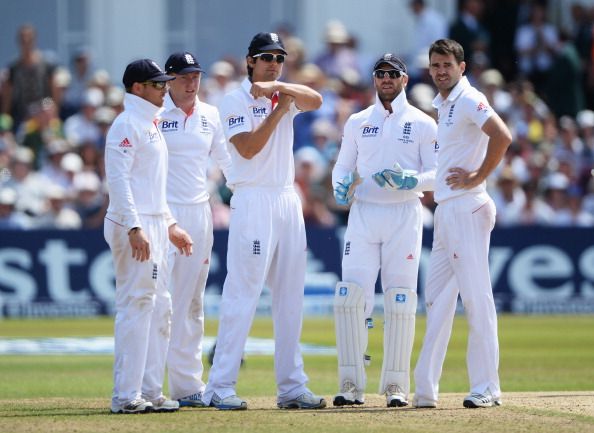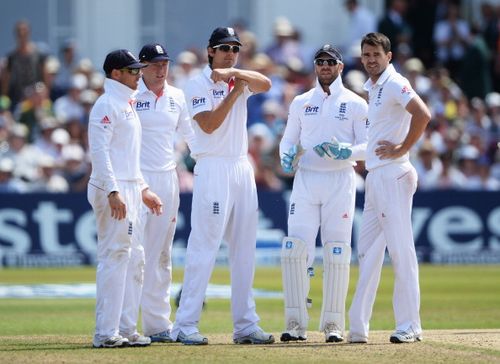
DRS: Dubious Review System

The 2013 Ashes had largely been about the Aussies capitulating at some times, imploding at the other. The status quo changed somewhat at Manchester before the rain gods decided to have a say in the match. But what continued unabated was the hullabaloo over the use of DRS system, which throughout the series has managed to throw up howlers at an impressive frequency.
In a relatively pristine, primordial cricketing era, the lack of technological advancements meant that the on-field umpires reigned supreme, their decisions unquestioned. There were, at times, glaring inadequacies, but the human eye can only gauge so much. Any and all misdemeanours, in the absence of alternatives, were romanticised and not brooded over.
Proponents of technology smacked their lips when DRS materialized into actuality. The system, however, had barely seen the light of the day when it was faced with some existential problems. Years after it came into being, it is now blamed for complicating the very things, which it was supposed to streamline.
Hot Spot, Hawk-eye and Snickometer, the three pillars on which DRS survives, are questionable per se. Hot Spot has been rather ineffective in conclusively settling matters in case of faint edges or near edges, and its success rate has been quantified at about 95-100%. And in case of close bat-pad calls, the snickometer is as good a judge as is the fielder far away at deep fine-leg. Hawk Eye has generally been good, though not completely immune to criticism. Saeed Ajmal had famously claimed that the hawk-eye, in certain cases, exaggerates the spin trajectory.
The DRS’s raison d’etre was to assist umpires in case of close calls, but paradoxically enough, the system itself is sometimes inconclusive.
Usmain Khawaja was the latest victim of the system’s frailties. A slew of replays showed no mark on the bat on Hot Spot, no deviation of the ball whatsoever, and the bat hitting the pad was unquestionably the sound that had prompted the incorrect decision on the part of the on-field umpire. Yet, somehow, Dharmasena upheld the umpire’s call after adjudging the evidences insufficient. This even led to the Australian PM Kevin Rudd giving air to his feelings on Twitter regarding this matter.
And this is not the sole instance when the DRS has marred the on-going Ashes. Trott, Agar, Pietersen – all have been unluckily and unfairly indicted.
Although much better than no system at all, the DRS path should be trodden with care given that it is now established that it is not infallible. And the entailing daily costs, coupled with the fact that a limited number of reviews is all that a captain has at his disposal, raises new questions about the system’s applicability.
If the system was to get rid of gaffes and improve the quality of umpiring, there hardly seems to be a point in having a limited number of review options during the course of a match. Is there any conclusive evidence that an umpire makes a maximum of two umpiring errors during the course of an innings in a Test match? If no, what then prompted the powers-that-be to allow only two unsuccessful attempts per side?
Some might argue that too many review calls have entailing horological considerations, and also tend to undermine the importance of the on-field umpires. But such reasoning must be shunned if one has to make the most of what is available. Broad’s refusal to walk, and Clarke’s helplessness at the absence of review calls had a great bearing in the final outcome of the first test. Ditto with Rogers in the second Test, where he made a mess of Swann’s embarrassing full-toss, but shied away from reviewing because one review was already down the drain, and he didn’t want to waste another.
Newer fiascos, each more interesting than the previous, keep surfacing every other day. Trott was given out despite the fact that he had clearly nicked the ball en route to his pad, but a lack of conclusive hot-spot footages led to debates about the influence of the human element involved in the decision making process even when DRS is consulted.
Then, there is the question of what constitutes enough ground to overturn (or uphold) an on-field umpire’s call in case of a review against a LBW appeal. Surely, a ball that hits the stumps with only a micrometer less than the radius deserves better than an outright rejection.
It is true, and has even been acknowledged, that the system needs to be overhauled. But at the same time, its usage has to be carefully monitored lest on-field umpiring becomes redundant. The applicability of the system, and its efficiency, need to be weighed against the howlers that have blown the lid off its can of worms.